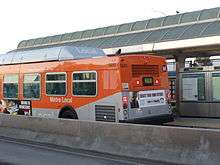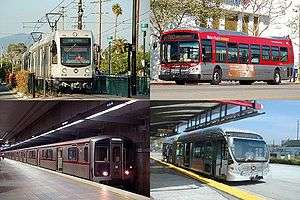Los Angeles Metro bus fleet
The Los Angeles County Metropolitan Transportation Authority (also known as "Metro ", "MTA", or "LACMTA") operates a vast fleet of buses. As of 2009, Metro operated the second-largest bus fleet in North America,[1] with a total of 2,472 buses.
Overview
Metro and its predecessor agencies have ordered buses from a variety of manufacturers over the years, including GMC, Flxible, Grumman, AM General, Transportation Manufacturing Corporation (TMC), Neoplan USA, New Flyer Industries, El Dorado National, Orion Bus Industries, Thomas Built Buses, Blue Bird Corporation, and North American Bus Industries (NABI). LACMTA has ordered over 1,500 buses from NABI in recent years, including purchasing an expanded fleet of 45-foot (14 m) buses, which they used to phase out their traditional 40-foot (12 m) vehicles.
Alternative fuels and vehicle technology
Metro is a major player in alternative fuel technologies, notably CNG, and the text "Nation's Largest Clean-Air Fleet" appears on the sides of many of its buses. The CNG fleet reduces emissions of particulates by 90%, carbon monoxide by 80%, and greenhouse gases by 20% over the 150 remaining diesel-powered buses in the fleet. Alternative fuel buses have logged more than 450 million operating miles since 1993, an industry record.
Metro has also increased its use of on-board vehicle technology. Most buses are equipped with monitors for Transit TV broadcasts and to display real-time bus maps to show the location through GPS navigation; the latter is the first of its kind in the United States. The screens have been shut off as of early 2015.[2] Also, as part of Metro's ATMS project, most buses include a marquee displaying the date and time, Automatic Voice Annunciation (AVA) for audio and visual announcements of each stop, and an audio and visual "Stop Requested" announcement. A supplemental audio announcement of "For your safety, please watch your step when exiting the bus" was added to all buses on February 28, 2013 and changed voice on March 2015.
Bus fleet
Metro has the second largest bus fleet in North America with 2,472 buses, behind New York City's Metropolitan Transportation Authority with 5,593 and ahead of Toronto's TTC at 2,031 (2,160 with Wheel Trans).
Active
| Make/ Model |
Length | Picture | Year | Numbers (quantity ordered) |
Current Paint Schemes | Engine | Transmission | Fuel propulsion |
|---|---|---|---|---|---|---|---|---|
| NABI 31-LFW | 31 feet |  |
2010 | 3100-3149 (49 buses) |
Metro Local |
|
CNG | |
| NFI XN40 | 40 feet |  |
2015-2018 | 3850-4199 (349 buses) |
Metro Local |
|
|
CNG |
| NFI C40LF |   |
2001 | 5300-5522 (222 buses) |
Metro Local Metro Rapid |
|
|
CNG | |
| NFI XN40 |  |
2013-2015 | 5600-6149 (549 buses) |
Metro Local Metro Rapid |
|
|
CNG | |
| NABI 40-LFW | ||||||||
 |
2001 | 7300–7514 (214 buses) |
Metro Local Metro Rapid |
|
|
CNG | ||
 |
2002 | 7600-7949 (349 buses) |
Metro Local Metro Rapid | |||||
 |
2005 | 7525–7599 (75 buses) |
Metro Local Metro Rapid |
|
| |||
| NABI 40C-LFW |  |
2003 | 7980-7999 (19 buses) |
Metro Local |
|
|
CNG | |
| OBI VI (06.501) | 2001 | 11000–11067 (67 buses) |
Metro Local |
|
|
Diesel | ||
| BYD K9 | 40-foot | 2015 | 1000-1024 (24 buses) |
Metro Local |
|
|
Electric | |
| NABI 45C-LFW | 45 feet | 2004 | 8000-8099 (99 buses) |
Metro Rapid Metro Liner |
Metro Liner (# 8005 only)
|
|
CNG | |
| NABI Metro 45C | 2008–09 | 8100-8400 (300 buses) |
Metro Local Metro Liner |
|
|
CNG | ||
| 2010-11 | 8401-8491 (90 buses) |
Metro Local Metro Liner | ||||||
| 2012-13 | 8500-8649 (149 buses) |
Metro Local | ||||||
| NABI 60-BRT | 60 feet |  |
2005-2006 | 9200-9399 (199 buses) |
Metro Local Metro Rapid Metro Liner |
|
|
CNG |
 |
2006 | 9400-9495 (95 buses) |
Metro Local Metro Rapid Metro Liner | |||||
 |
2007–08 | 9500-9594 (94 buses) |
Metro Local Metro Rapid Metro Liner |
Retired (incomplete)
| Make/Model | Length | Picture | Year | Numbers
(quantity ordered) |
Current Paint Schemes | Engine | Transmission | Fuel Propulsion |
|---|---|---|---|---|---|---|---|---|
| Gillig Spirit | 28 feet | 1990 | 600
(1 bus) |
Yellow Jacket | Cummins B5.9 | Allison MT-645 | Diesel | |
| Gillig Phantom | 40 feet | 1991 | 813-817
(4 buses) |
None | Detroit Diesel 6V92TA | Allison HT-748 | Diesel | |
| Eldorado National Aerolite | 21 feet | 1998 | 0005
(1 bus) |
Yellow Jacket | Propane | |||
| Ford Econoline 350 | 25 feet | 1989 | 0006
(1 bus) |
Yellow Jacket | Diesel | |||
| GMC RTS-04 (T8J-204) | 40 feet | 1980-1981 | 0023-0025
(3 buses) |
Purple Connector | Detroit Diesel 6V92TA | Allison V730 | Diesel | |
| Eldorado National Aerotech | 25 feet | 1997 | 0025
(1 bus) |
Yellow Jacket | Propane | |||
| Gillig Phantom | 40 feet | 1994 | 1000-1010
(10 buses) |
None | Detroit Diesel Series 50 | Allison B400R | Diesel | |
| BYD K9 | 39 feet | 2014 | 1001-1005
(5 buses) |
Metro Local | Electric | |||
| Neoplan USA AN440A/3 | 40 feet | 1987 | 1100-1189
(89 buses) |
Yellow Jacket | Detroit Diesel 6V92TA | Allison V731 | Diesel | |
| TMC RTS-06 (T80-206) | 40 feet | 1992 | 1200-1502
(302 buses) |
Yellow Jacket
Metro Local |
Detroit Diesel 6V92TA | Allison V731 | Diesel | |
| Flxible Metro B CNG | 40 feet | 1989 | 1800-1809
(9 buses) |
Tri Stripe | Cummins L10G | Voith D863.3 | CNG | |
| TMC RTS-06 (T80-206) | 40 feet | 1989 | 1970-1999
(30 buses) |
Yellow Jacket
Metro Local |
Detroit Diesel 6V92TAC | Allison V731 | Diesel | |
| TMC RTS-06 (T80-206) | 40 feet | 1988 | 2000-2266
(266 buses) |
Yellow Jacket
Metro Local |
Detroit Diesel 6V92TAC | Allison V731 | Diesel | |
| TMC RTS-06 (T80-206) | 40 feet | 1993 | 2006
(1 bus) |
None | Detroit Diesel 6V92TA | Allison V731 | Diesel | |
| TMC RTS-06 (T80-206) | 40 feet | 1989 | 2300-2402
(102 buses |
Yellow Jacket | Detroit Diesel 6V92TAC | Allison V731 | Diesel | |
| Flxible Metro B | 40 feet | 1988 | 2500-2649
(149 buses) |
Yellow Jacket | Cummins L10 | Voith D863.2 | Diesel | |
| Flxible Metro B | 40 feet | 1989 | 2700-2764
(64 buses) |
Yellow Jacket | Cummins L10 | Voith D863.2 | Diesel | |
| Flxible Metro B | 40 feet | 1990 | 2800-2870
(70 buses) |
Yellow Jacket | Detroit Diesel 6V71TAC | Allison V731 | Diesel | |
| Flxible Metro B | 40 feet | 1992 | 2900-2932
(32 buses) |
Yellow Jacket | Detroit Diesel 6V71TAC | Allison V731 | Diesel | |
| New Flyer D40LF | 40 feet | 1998 | 3000-3019
(19 buses) |
Metro Local | Detroit Diesel Series 50 | Allison B400R | Diesel | |
| Neoplan USA AN440A | 40 feet | 1983-1984 | 3300-3714
(314 buses) |
Yellow Jacket | Detroit Diesel 6V92TA | Allison HT-747
Allison HTB-748 |
Diesel | |
| NABI 42-BRT | 42 feet | 2009 | 4200-4205
(5 buses) |
Metro Local | Ford Triton V10 6.8L | ISE Thundervolt TB40-HG Hybrid Drive System | Gasoline-Electric | |
| GMC RTS-04 (T7J-604) | 35 feet | 1982 | 4400-4434
(34 buses) |
Yellow Jacket
Metro Local |
Detroit Diesel 6V92TAC | Allison V731 | Diesel |
Bus divisions
Under the Metro governance structure, the routes operating out of each division are supervised by an integrated/centralized operations division with oversight provided by Service Councils composed of elected officials, appointed representatives, and transit users from a given area served by each division. While the Councils have geographical boundaries, in practice they only define where the members come from, as most of Los Angeles is served by routes operating out of multiple sectors. For instance, the Olympic Boulevard Rapid bus is operated by buses from the San Gabriel Valley sector, despite its entire route being in the Westside or Central Los Angeles areas. A list of routes operating from each sector can be found on the Metro web site.
The SGV-3 in Cypress Park is the oldest bus yard in Metro history, which has been operating since 1907. It is home to 200 buses.
Service sector abbreviations and division numbers are affixed to the windows and sides of many Metro buses. Some also have circular decals with the division name and an illustration in a style similar to that used in New York City and New Jersey.
The following table lists all current bus divisions (rail divisions are not included):
| Number | Name | Sector |
|---|---|---|
| 1 | Central City | Gateway Cities |
| 2 | Crossroads Depot | Gateway Cities |
| 3 | North Los Angeles, Cypress Park | San Gabriel Valley |
| 4 | (non-revenue vehicles) | Gateway Cities |
| 5 | Arthur Winston, Mid-Cities | South Bay |
| 7 | West Hollywood | Westside/Central |
| 8 | West Valley | San Fernando Valley |
| 9 | El Monte, San Gabriel Valley | San Gabriel Valley |
| 10 | Gateway | Westside/Central |
| 13 | Downtown Los Angeles | Central Maintenance Facility (CMF) |
| 15 | East Valley | San Fernando Valley |
| 18 | South Bay | South Bay |
Closed divisions
The following table lists all former divisions.
| Number | Name |
|---|---|
| 6 | Venice |
| 12 | Long Beach |
| 14 | South Los Angeles[4] |
| 16 | Pomona |
See also
- Bus transportation in California
- Los Angeles County Metropolitan Transportation Authority topics
- Los Angeles Metro Rail rolling stock
References
- ↑ Roman, Alex (September–October 2009). "Top 100 Transit Bus Fleets" (PDF). Metro Magazine. Vol. 105 no. 8. p. 22. Retrieved 2009-11-05.
- ↑ http://thesource.metro.net/2015/02/10/metro-statement-on-transit-tv-monitors-on-buses/ Metro statement on Transit TV monitors on buses
- ↑ https://www.newflyer.com/rss/758-new-flyer-expands-clear-air-propulsion-leadership-with-the-cummins-westport-isl-g-near-zero-emissions-engine
- ↑ Reclaimed bus yard begins life as urban wetland Los Angeles Times Feb. 10, 2012
